Update: In December 2023 I was contacted again by the Hans Hass Archive, who archived all things around Hans Hass’ life. Fortunately for me, most of the documents and correspondance of Hass and Enicar were saved. Big thanks to Michael Jung, founder of the Hans Hass Archive, who provided the files and made some new discoveries possible. Therefore I update this article from 2022 at the important and new parts.
We all know that Enicar watches, especially the Sherpa ones use highly waterproof cases, build by Erwin Piquerez SA, short EPSA. Those compressor cases are iconic and used by several companies as well. The ones for Enicar though, are special. Instead of a screw back , EPSA and Enicar developed the bayonet caseback. This is a feature you only find on Enicar watches. The first watches with that system, like the one in the following ads, appeared in 1955.


As you can see, those early dive watches are missing a bezel, as we know from dive watches today. In 1957 the famous Austrian dive pioneer Hans Hass was asked to test the newest Enicar dive watch on his next big expedition. On June 24th, 1957 the “Public Relations Group” was contacting Hans Hass in the name of Enicar, if he is open for a colaboration with them. After some meetings and calls with the Enicar Marketing Chef Laurent Robert-Tissot, they agreed on a contract, worth 13.000 Sfr on August 14th, 1957. See the following (German) original documents attached:


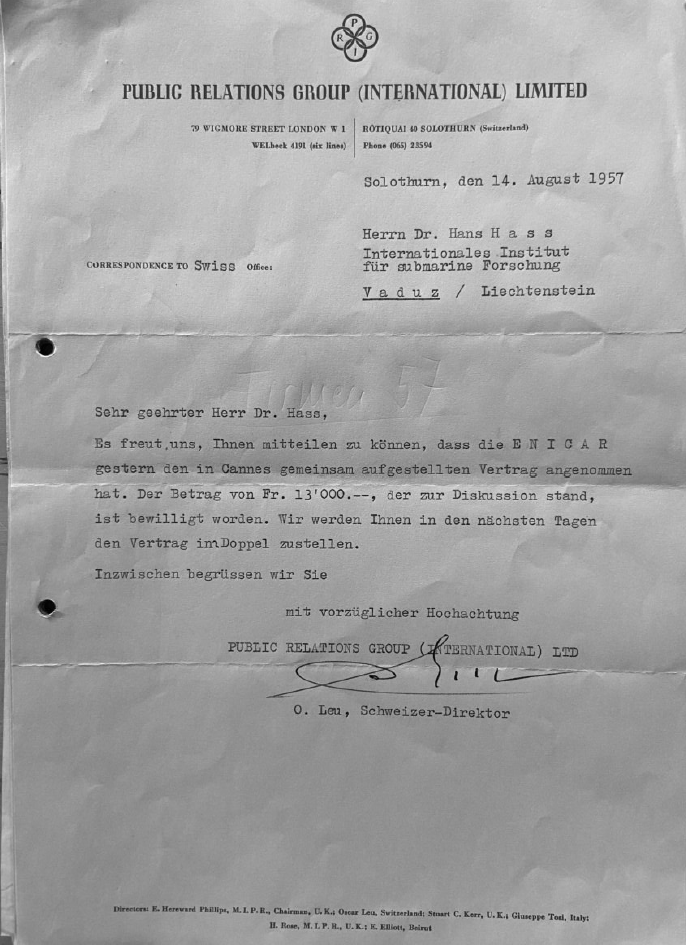

After the contract was done, Enicar was preparing 6 prototype dive watches for Hass and his team from September 15 to 20. The watch was called “Chronometer Sherpas” which leads to two assumptions. The name of the watch wasn’t ready yet, and like on the Geopyhiscal Year Expedition, the delivered their testiomonial watches in chronometer configuration. The watch we are talking about of course is the later known Enicar Sherpa Dive, a 40mm dive watch with rotating bezel and watertight till 600ft. The early examples had a bakelite bezel with radium lume. Later examples had alloy bezels with tritium lume dots at 12 o’ clock only.

In 1957 Hass planned a scientific adventure to beautiful dive spots to study the underwater scenery. It was called the Xarifa II Expedition supported by the International Institute for underwater sciences, Vaduz. Hass was the head of the expedition together with science director Dr. I. Eibl-Eibesfeldt. The project started on October 15th, 1957 in Cannes, France. They sailed all the way through the Red Sea, Abdel Kuri, the Maldives, Cylon (Sri Lanka), the Nicobar Islands till the end of that amazing journey at Singapore.


The Expedition was named after the ship they used during their trip. The Xarifa was a proud ship, build in 1927 in England. It was used as yacht by the sewing machine king Franklin Morse Singer at the beginning. Unfortunately it ended as a coal ship in the 40s.
Hass bought what was left of this ship and rebuild it to a maritime science ship and to his specific needs.

An expedition like this was a very expensive project and so Hass needed and found a lot of sponsors, like the BBC (who got a 26 part TV-documentation for their money), Philips, Leica, Grundig, Kodak and many others.
As mentioned before, Enicar supported Hass with some new dive watches. They sent six of them to his team, Reference 100/124 BaANXS. Since the ship left Cannes on October 15, 1957, the watches needed to arrive way earlier. The oldest Sherpa Dive I know of, has the markings 11/57 in the caseback and makes it a november production model earliest. This would be to late for Hass’ expedition start.
After I got the documents from the Hans Hass Archive, its clear they sent the watches before the start. Enicar shipped them on September 28th, 1957, now under the name Enicar Ultrasonic Sherpas (specially designed for deepsea diving) and Hass affirmed their arrival on the day, the expedition started.



Also notable are the mentioned numbers in the document:
| 3061 |
| 3068 |
| 3074 |
| 3090 |
| 3099 |
| 3173 |
For serials those numbers are a bit short. Back in 2o22 I had two theories:
I. Those numbers were test examples and the numbers were engraved on the outside of the watch, like on the caseback. But why aren’t they chronological, like 3060, 3061, 3062..and so on?
II. Early Sherpa Dives were also advertised as “Sherpa Dive Supertest”. Supertest stands for Enicars own category of chronometer movements. Every Supertest movement is marked with an additional number. To my knowledge Enicar started with the Supertest campaign in the late 50s, so maybe those Sherpa Dives were among the first.
Now in 2023 with more info and knowledge we can rule out both. The numbers are the specific numbers for Enicar Chronometer watches, as they were also used at the Geophysical Year Expedition a year earlier. The numbers are marked on the caseback outside and additionaly on the movement.

After the expedition Hass needed to give the watches back to the Enicar headquarter for further tests and investigations.
Regarding to the Hans Hass Archive he also had the task to write an evaluation about the watches. Unfortunately those documents are still missing but will be hopefully rediscovered one day. His first feedback to the documents above were the following:
“I would like to congratulate you on your watch. It is comfortable to wear and is ideally suited as a diver’s watch.”
The earliest pic where we clearly can identify a Sherpa Dive on the wrist of some of the scientists from the Xarifa II expedition is from December 1957. It’s on the wrist of Hans Hass himself, taking some pictures at the beach of Abdel Kuri, an Island next so Somalia. Easiest way to spot the watch is the white Tropic strap for sure.


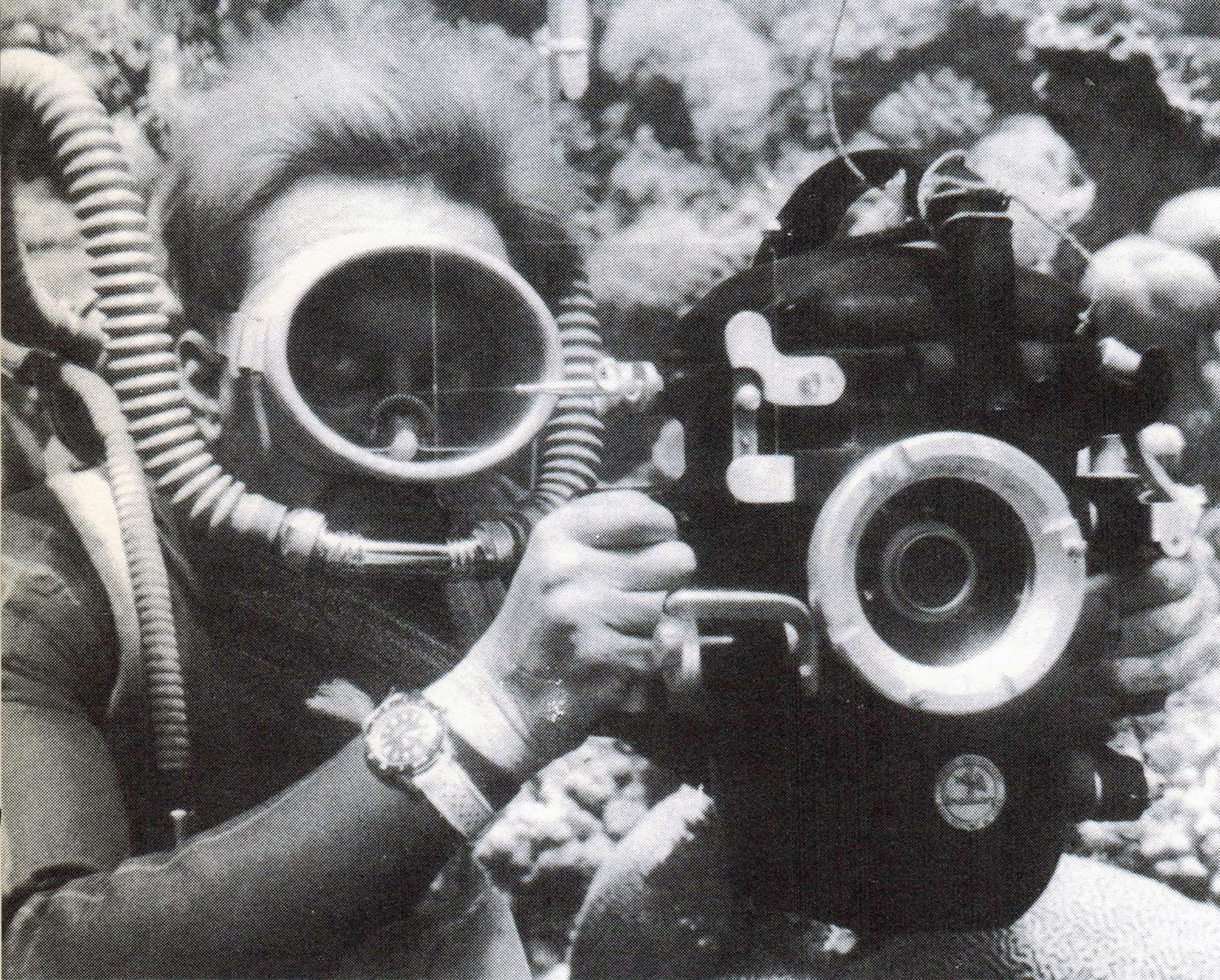
An interesting fact I just discoverd in the archive documents, is that the watches initially were delivered with “Fixoflex” bracelet. These bracelets were used on a lot of watches in the 50s and easy to wear, but also known as “hairkiller”. an Example is the Longines Legend Diver. For Hass though, these bracelets were a problem. Regarding a response from Enicar to him, Hass’ team lost two watches due to the bracelet. Also one watch was stopped working, so Enicar prepared three new deliveries, also with minor updates on the dial. I assume the watch finally got their name on the dial, since in this letter they now call the watch “SHERPA-Dive”. I also found a short spot in the Hass Xarifa TV documentation, where you can see a Sherpa Dive on a Fixoflex.


Most of the pictures I show here are from the Book “Expedition ins Unbekannte” (“Expediton into the unknown”) that Hass wrote after the journey was ended. I havn’t just found pictures of the watch in the book, but also an interesting anecdote.
“In the course of our hard work Eibl [another Team member] lost his diving watch. But everything worked out well here, and the next day I found it again. The Enicar company asked us to subject this newly developed watch to particularly severe strain. This had happened. A huge parrotfish mistook the watch for a shell and tried it’s teeth on it. The traces were clearly visible, but the clock was still on time as before. “
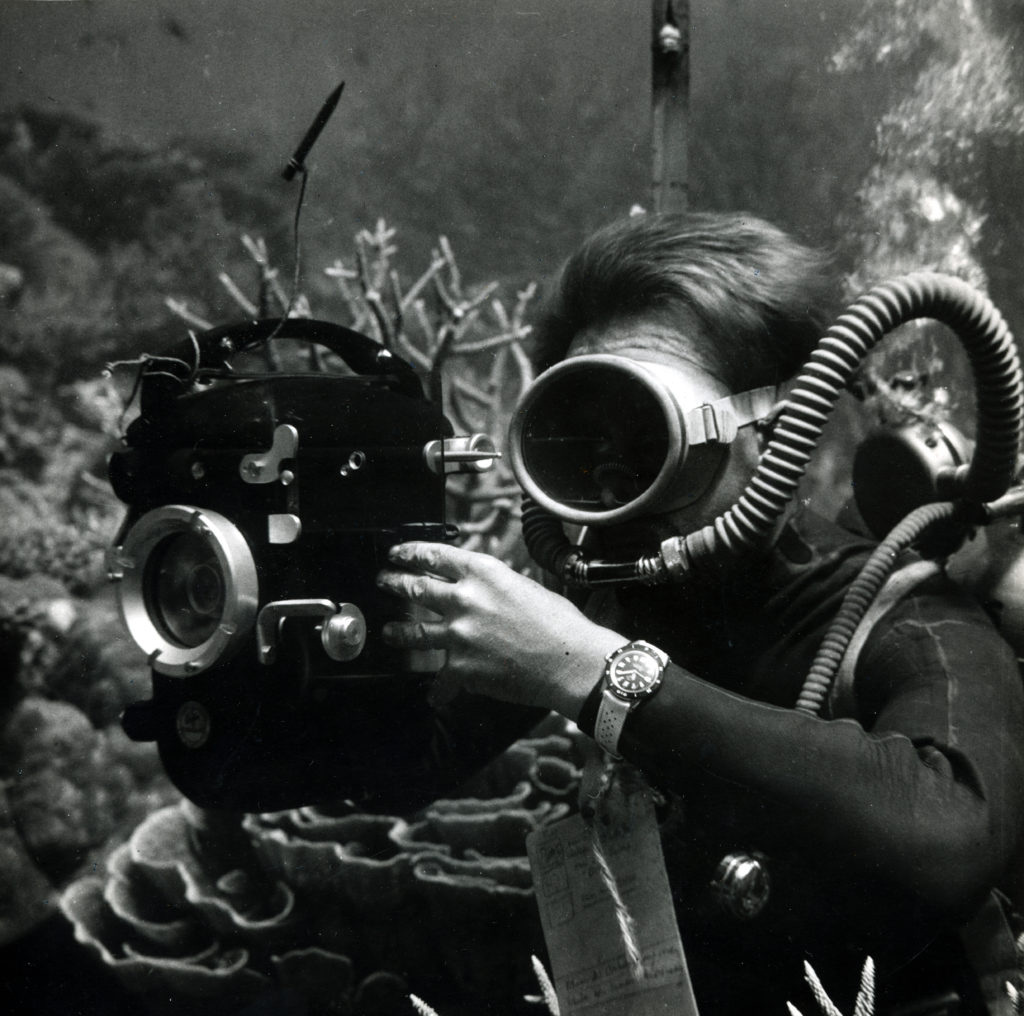
A Sherpa Dive is not just water- but also parrotfish-proof!
Hass also wrote a few lines about the watch in the “Thank you” chapter of the book. He stated the following:
“The waterproof diving watches “Sherpa-Dive”, which we received for testing from the Enicar company in Lengnau, proved to be the best during the year-long exertion. I have already told you how one of the clocks defied the teeth of a giant parrot fish. The watch can be recommended to every diver. We would like to thank Director 0. Leu from the Public Relations Group in Solothurn, who established the connection to Enicar.“
Sounds like he and his team were satisfied with the results of their evaluation and the watch itself. Its not suprising that Hans Hass gave his name for advertising campaigns of Enicar till the end of the 60s. In fact, he was one of the first testimonials Enicar used for advertising watches all around the globe. Hans Hass was like the superstar of underwater adventures and discoveries, years before Cousteau.
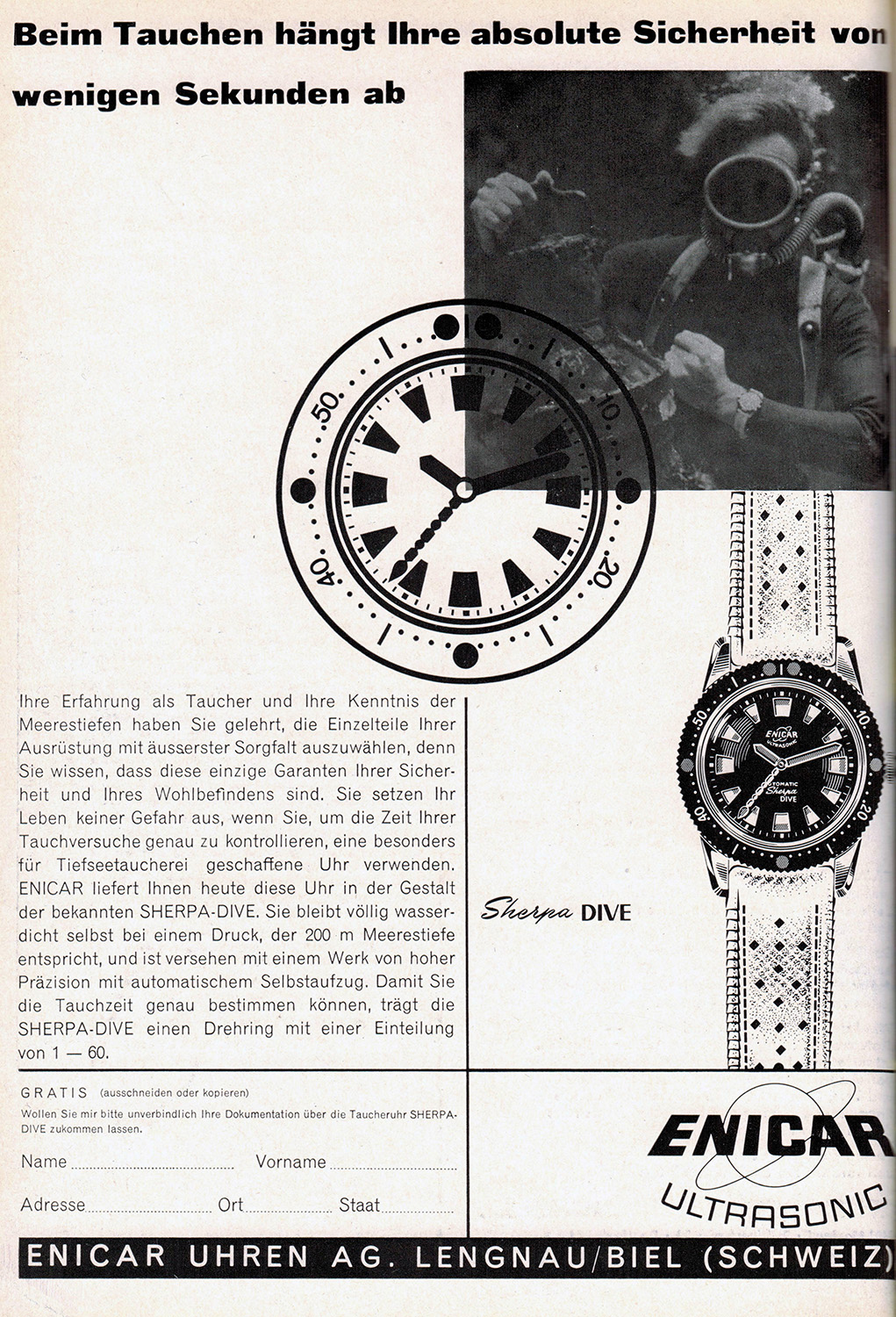


But the new documents also show, it wasn’t allways easy to work with him. Enicar waited months for usable pictures of him and his responses came sporadic. Of course the Internet, Email and messangers weren’t invented yet, but Hass’ seemed to be a challenge for the advertising appartment over the years. Nevertheless their worked on a new contract, worth 20.000 Sfr now. When Enicar asked him, how he can support him and if it is worth it, Hass replied professional, but also with a gun on their chest: Rolex was allready knocking on his door so he advised Enicar to act fast, since it would be look bad for them, if he would change for Rolex now.



The Xarifa II expedition was a great success. Especially the TV-documentary is well remembered and was for most of the people watching it the first view into another world: the beauty of the sea and its inhabitants. The supporting book my research is based on is also very entertaining.
I also found some super cool footage from the original TV show, showing and introducing Hass’ Enicar Dive.
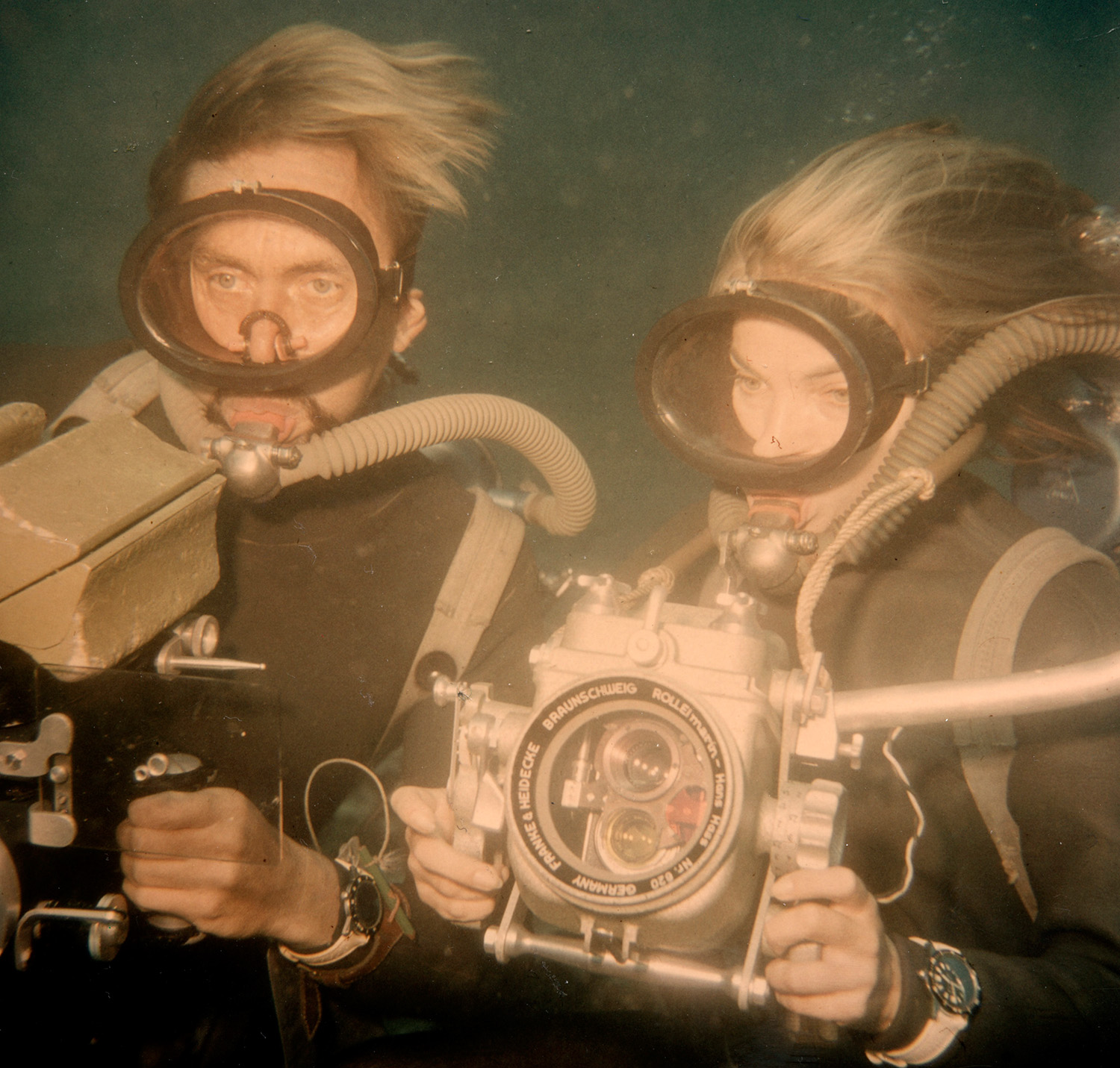



In 2021 I had the chance to buy a genuine unpolished early Sherpa Dive with original white tropic strap myself. As you can see, there are differences to the later models. Besides the allready mentioned high Radium Bakelite bezel, it contains a different movement (AR 1034, based on an AS movement) and the crown is without the famous waffle pattern. You can also see, that the Sherpa line is still called Sherpas on the caseback, but Sherpa on the dial.
The watch with Ref. 100/124 BaANXS is one of the gems of my collections, since the bakelite bezels are very delicate. The Radium on the one hand, but more relevant, most of those bezels are broken. To find a 40mm model (there are also the 36mm Divettes and Diver 600 in a similar configuration) is difficult nowdays. If you see one, don’t hesitate to buy!

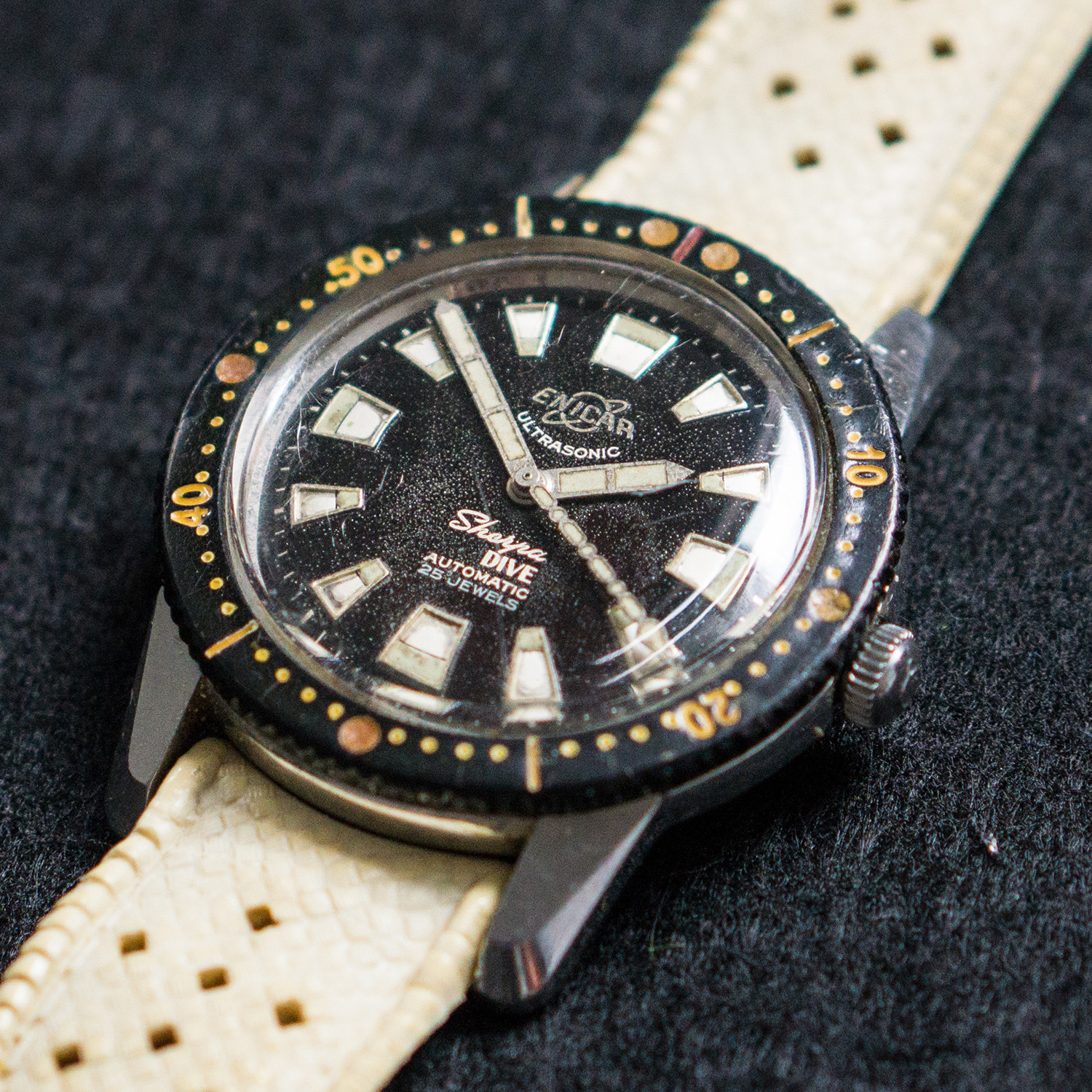



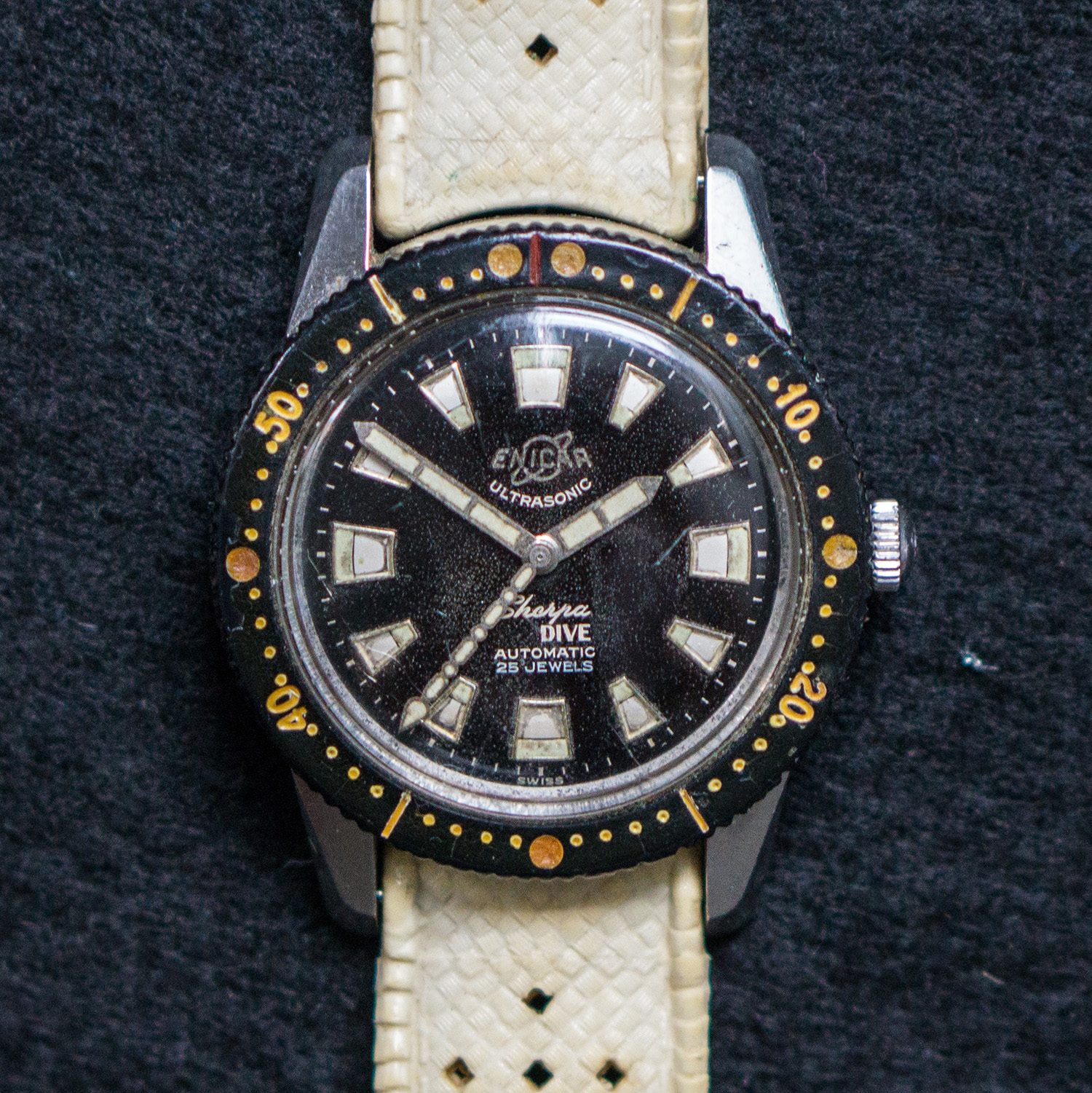
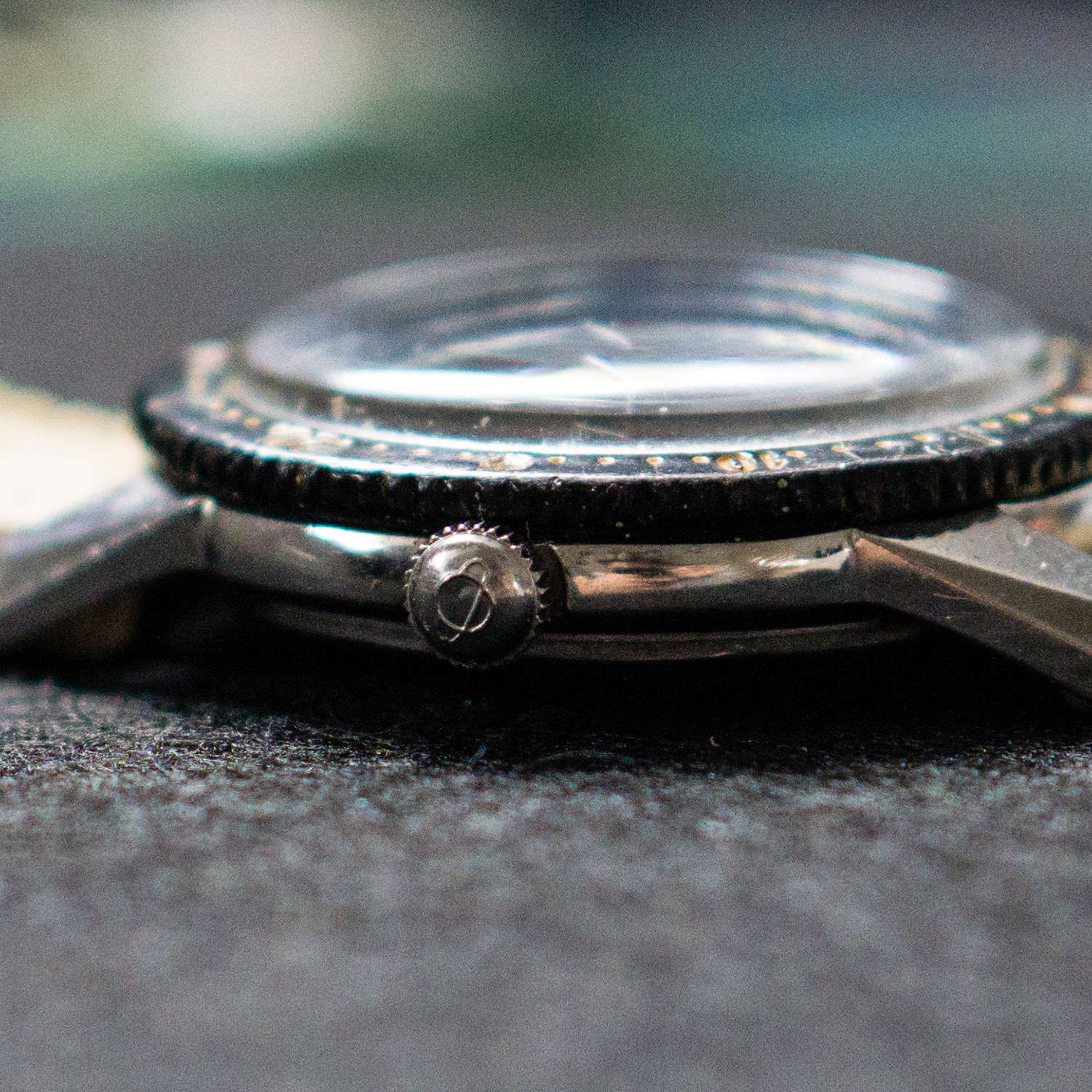
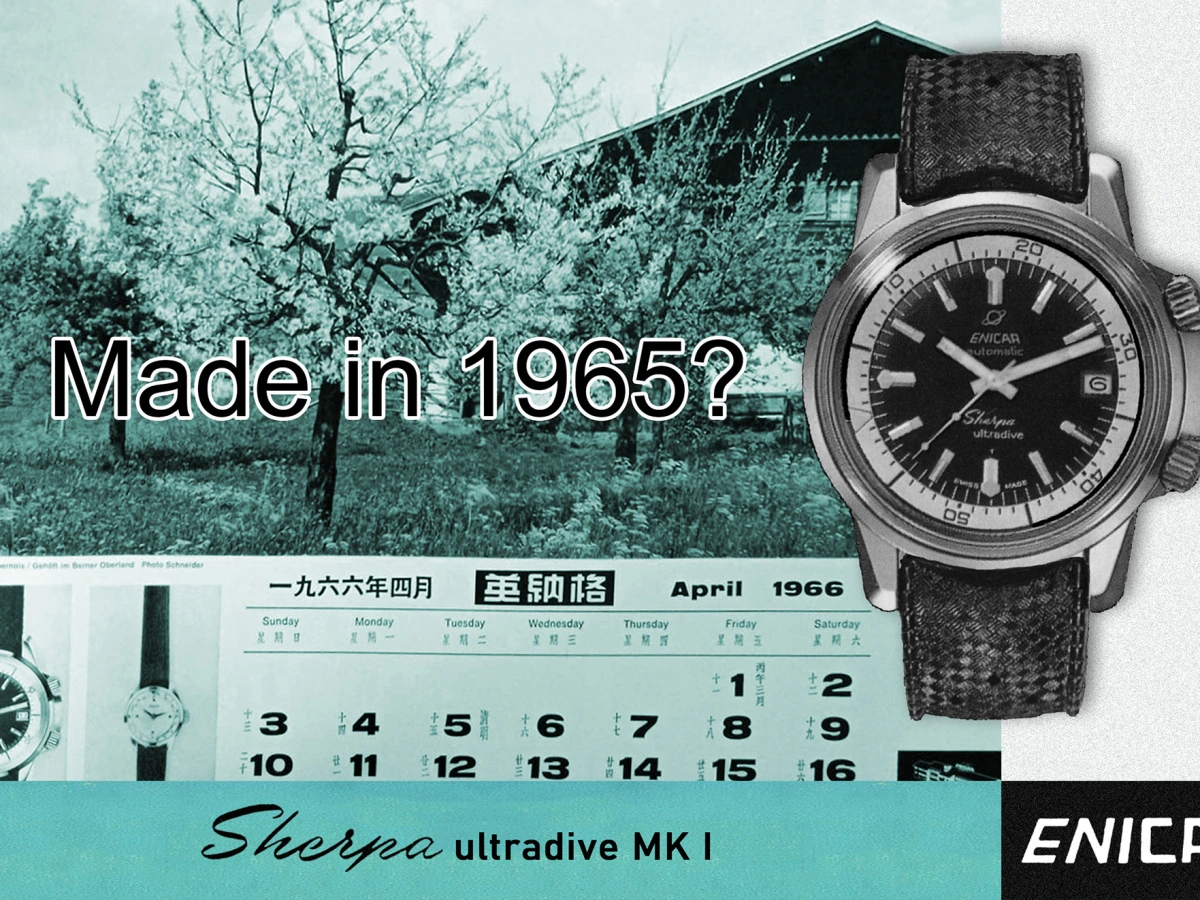
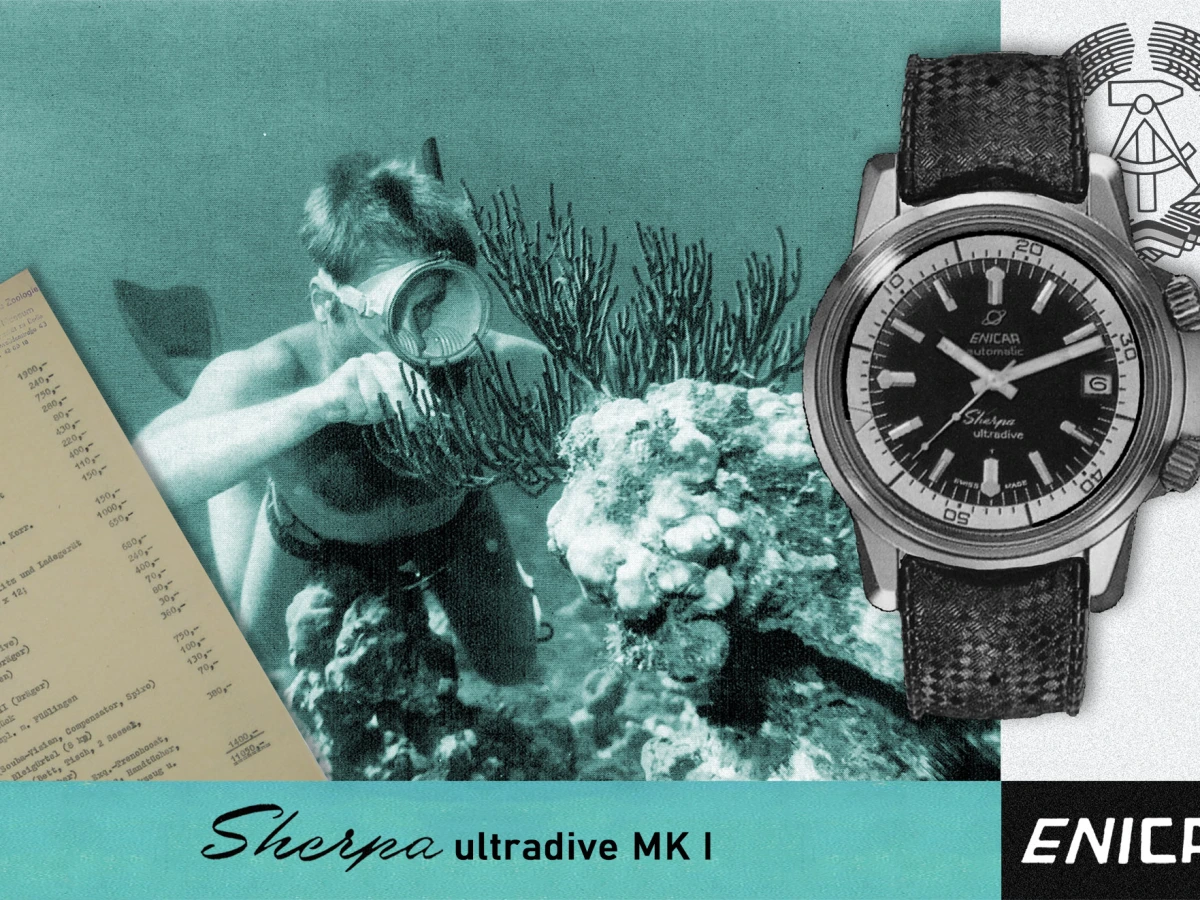
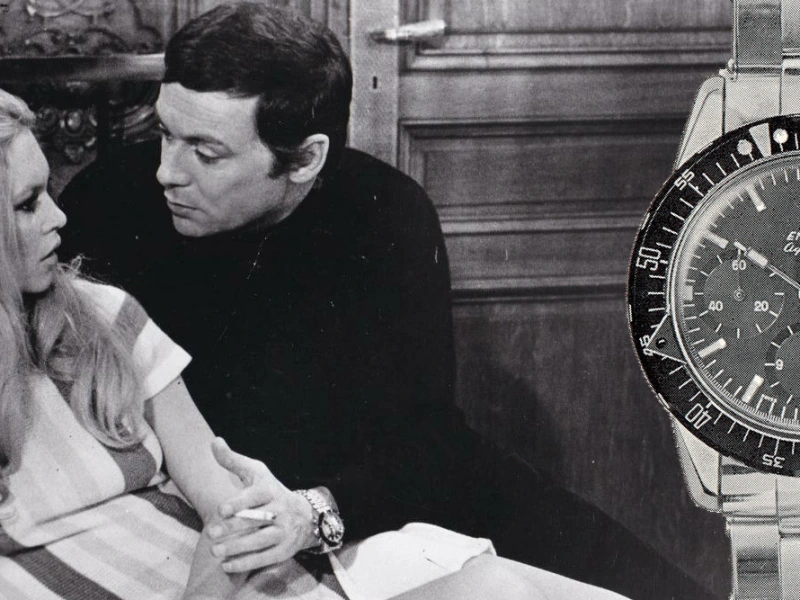
Great blog, love those vintage watches with great stories.
LikeLike